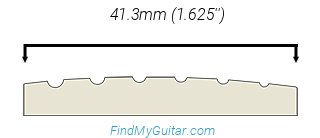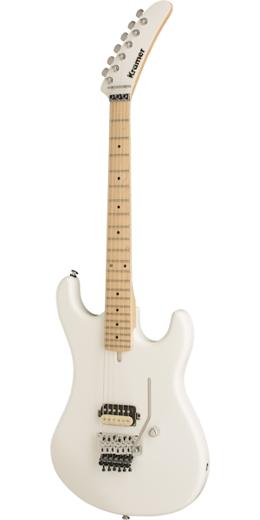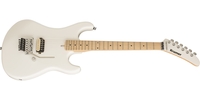EVH Striped Series vs Kramer The 84
Reasons to Get
EVH Striped Series over Kramer The 84
Reasons to Get
Kramer The 84 over EVH Striped Series
Other Key Differences
EVH Striped Series vs Kramer The 84
Shared Features
EVH Striped Series vs Kramer The 84
Common Strengths
- Retainer Bar
- High-Quality Nut
- Top Pickup Brand
Common Weaknesses
- Neck-Through Build
- Weight Relief
- Stays in Tune (Evertune)
- High-Quality Frets
- Compound Radius Fretboard
- From a High-Quality-Standards Country
- Luminescent Sidedots
- Strap Lock
- Expensive Wood
- 21:1 Tuner Ratio
- Active/Passive Preamp
Price History Comparison
These are affiliate links. We may earn a fee if you purchase after clicking. These prices are prone to error. Make sure you're buying the right product after clicking on a link from our site. We are not liable if you buy the wrong product after following these links. As an Amazon Associate site we earn from qualifying purchases.
Which One is Better for Beginners?
Both meet 4 out of our 8 criteria items for beginner friendliness. This takes into account the type of frets, scale length, nut width, bridge type, fretboard radius, and neck profile to determine the easiest combination for new players. If you're looking for your first guitar to learn how to play, you can't go wrong with either of them.
New Player Friendliness
EVH Striped Series- Comfortable shape
- Comfortable fretboard
- Tall frets
- Comfortable neck
- Narrow nut
- Short scale
- Locking tuners
- Easy-to-use bridge
New Player Friendliness
Kramer The 84- Comfortable shape
- Tall frets
- Narrow nut
- Comfortable neck
- Comfortable fretboard
- Short scale
- Locking tuners
- Easy-to-use bridge
Nevertheless, when it comes to choosing an instrument, you should pick the one more compatible with your personal style. Still, below we'll try you to give you our results as objectively as it's possible to help you decide.
Sound Quality Comparison
The wood used in an electric guitar or bass is not as important to determine the final tone. However, some people prefer specific wood types, so we'll take a look at those first. Then, we'll take a look at the electronics to determine the versatility and sound quality of each instrument.
Woods Used in Both

Maple is one of the most popular necks for good reasons. It is a strong wood that is relatively cheap to make and looks beautiful. The highest quality maple is the hardest that comes from North America. Find out more about Maple.
Woods Used in the EVH Striped Series

Basswood is a lightweight type of wood that isn't as expensive as other popular choices for guitar building. It gives more power to the mid-range frequencies. Its color can vary from pale white to light brown. Find out more about Basswood.
Woods Used in the Kramer The 84

Alder is the most popular wood that Fender uses in most of their guitars nowadays. Even though they say it's because of its balanced tone with an emphasis in the upper midrange, it probably is because it isn't too expensive, and it's also pretty lightweight—more than Mahogany. Find out more about Alder.
Winner: Tie.
Pickup Configuration
Both pickup configurations are H. A single H pickup gives you the advantage of having a little longer sustain (all other things being equal) because there will be less magnetic fields from other pickups affecting the strings' vibration. However, they also give you the least versatility because you won't have other pickups at different distances from the bridge to create different tones. A single humbucking pickup is used for noiseless high output, which is used mainly for Hard Rock genres.
Pickups Quality
Both come with very good pickups from at least one of the specialized brands in the market. With pickups like these, you probably won't need an upgrade anytime soon.
We found the same or similar pickups to the Kramer The 84's online:
Both use Passive pickups. This is what's used for most music genres. They have a regular output and will serve you for both high-gain and clean tones. The alternative (Active pickups) offer a higher output that is mostly used for heavy music.
Winner: Tie.
Versatility Comparison
Some instruments offer you more ways to explore your creativity than others. Below you'll find how both compare when it comes to versatility.
Switch Options
Both are equal when it comes to the pickup switching option.
Only the Kramer The 84 comes with some kind of pickup modification: Parallel Split.
The Parallel Split feature allows it to split and connect some of the pickups in parallel. When wired in parallel, the result is a very bright tone. This is the wire technique used in most Stratocaster guitars, and it's what gives them their signature transparent and clear sound. This is because the pickups' inputs and outputs are wired together, which reduces the signal's travel distance to the output jack.
In this case, both of them lack pickup selector.
When evaluating versatility, we also take into consideration bridge and neck joint type, number of frets, switch options, amount of pickups and more.
Winner: Kramer The 84.
Final Sound Quality Scores
Build Quality Comparison
When it comes to build quality, we like to take into account everything used to build the instrument. This includes materials, hardware and the quality control expected depending on the country where it was built. Let's see how the EVH Striped Series compares to the Kramer The 84.
Country of Origin
The manufacturing country can tell a lot about the build quality of an instrument. The EVH Striped Series is built in Mexico while the Kramer The 84 is made in Indonesia.
Mexico has been for a long time where Fender has built their semi-premium series. If you don't want to overpay for a wellp-built instrument, a guitar built in this country by a good brand always offers good value for the money.
Indonesia is becoming the most popular country for guitar building because they can make good instruments for a low price. Some people think that they're 'the new China' when it comes to build quality. But the truth is that Indonesian guitars are more consistent, although Chinese quality has improved a lot in the last few years.
Winner: Tie
Nut Material
If you want your guitar to stay in tune and sound good, you need a well cut nut. Nut quality can be inconsistent even when comparing two copies of the same model. The best way to make sure you're nut will be well done is by getting a nut made by an expert company like TUSQ or Micarta.
In this case, both have Locking nuts. Instead of a regular nut, this guitar has a locking system that will lock down the strings at the nut, preventing it from getting out of tune. It removes one of the disadvantages of tremolo bridges, tune stability.
Both models come with a retainer bar, which is helpful when changing the strings on a double-locking tremolo. Without it, the strings would change pitch once you lock down the nut, so you'd have to make more micro-adjustments at the bridge to tune it correctly
Winner: Tie.
Fret Material
Most fret wire is made of nickel silver. This material eventually wears down after a lot of use and most instruments end up needing a complete fret replacement. However, some expensive models come with stainless steel frets. This is what you should aim for if you can afford it.
Unfortunately, none of them come with stainless steel frets.
Winner: Tie.
Bridge
The perfect bridge for you will depend on your playstyle because they all have advantages and disadvantages. However, some bridges are more expensive—like Floyd Roses and Evertunes—and thus add more value to a guitar.
Both come with a similar bridge: Floyd Rose. This is a double-locking bridge system that allows you to perform techniques like dive bombs and pinch harmonics. The locking nut allows your guitar to stay in tune even after the most intense tremolo usage. The disadvantage is that it takes more work to change the strings and set up everything correctly.
Since we need to be objective, the most expensive type of bridge will be the winner of this section. In the end, this doesn't matter if you're not going to use the bridge for its original purpose, so choose the bridge that fits your playing style better.
Winner: Tie.
Tuners
Both come with regular tuners. The EVH Striped Series's are EVH-Branded Gotoh while the Kramer The 84's are Mini Die Cast
Winner: Tie.
Neck Joint
Contrary to popular belief, the difference in sustain and tone that some neck joints give to a guitar is simply unperceivable—if they're all well built. However, some of them do have advantages over the others.
Both have a Bolt-On neck joint. This neck is joined to the body by 4 bolts that you can simply unscrew. This allows you to replace the neck or take it off for travel. It's the most common and cheapest way to build a guitar.
Winner: Tie.
Here is the list of features that were considered when choosing the winner in the Features subcategory:
EVH Striped Series
- Locking Nut
- Top Brand Pickups
- Tremolo
- Compound Radius Fretboard
- Retainer Bar
- Cheap Fret Wire (NS)
- No Locking Tuners
- Made in Mexico
- No Expensive Woods
- No Neck-Through Build
- No Push Knob or Extra Switch Option
- No Weight Relief
- No Luminescent Inlay
- No 21:1 Tuner Ratio
- No Strap Lock
Kramer The 84
- Locking Nut
- Top Brand Pickups
- Parallel Split Pickups
- Tremolo
- Retainer Bar
- Cheap Fret Wire (NS)
- No Locking Tuners
- Made in Indonesia
- No Expensive Woods
- No Neck-Through Build
- No Weight Relief
- No Luminescent Inlay
- No Compound Radius Fretboard
- No 21:1 Tuner Ratio
- No Strap Lock
Final Build Quality Scores
Playability Comparison
Let's now compare their playability. Bear in mind that the instrument will feel different depending on your hand size and play style. That's why you should always test before buying. But if you can't or want a second opinion on it, we can still take a look at each of the important measurements of the instrument for you. This way, we can predict how easy a guitar might be to play, or how different it will feel compared to the other.
Remember that, even though the difference might seem small, every inch counts when it comes to feeling of the instrument in your hands. Any variation can completely change how comfortable a guitar feels in your hands.
Nut Width


The nut width will affect the separation between strings at the nut. In this comparison, the EVH Striped Series has the wider nut with 42.9mm (1.688'') vs 41.3mm (1.625''). This is a 1.6mm (0.063'') difference
This means that it will be more difficult to do bar chords on the EVH Striped Series, especially closer to the nut. However, it's also easier to play without muting strings accidently. This favors people with big hands.
Scale Length

The scale length is one of the things that influences playability the most. This is the distance between the nut and the bridge and will affect everything from low action allowance, difficulty to perform bends, fret separation, and even tone.
In this case, both have a scale length of 25.5".
This is the scale used in most Stratocasters. It's slightly longer than the typical 24.75'' size found in Les Pauls, and it's one of the main reasons why Stratocasters have such a bright sound in general. A longer scale also means that the strings will have higher tension. This will help you get lower action without suffering fret buzz, which will also be helpful when playing in lower tunings without having to increase your string gauge.
However, this also means that there will be more separation between frets, which can make it more difficult to play. Also, bending the strings will require more strengths due to the increased tension, but remember that a tremolo guitar will offset this difficulty.
Lastly, remember that you can also affect the tension of the strings by changing your string gauge. You can use a thicker gauge for more tension and a lighter one for less tension.
Neck Profile


No single neck shape is better than others. However, most people tend to prefer a thinner necks because it doesn't get in their way when playing fast and most hand sizes can adapt to it pretty well. However, some people still prefer thicker necks for a better grip, especially if they have big hands.
Both the EVH Striped Series and the Kramer The 84 have a C-shaped neck. This is what you'll find in most modern guitars. Most people feel like the thickness of a C neck is simply the less intrusive one for playing fast, while at the same time allowing you to grab the neck easily for resting if you want to.
Fretboard Radius


Most guitar fretboards are not flat; they usually have a curve or arc across their width. A curved fretboard will make it easier to perform chords without muting strings, while a flatter one will make it easier to play single notes, which is good for bending and soloing in general. The best fretboards have a compound radius that varies across the fingerboard, but they're not common since they take a lot more work to build.
In this case, the EVH Striped Series is the only one with a compound radius. This is a huge win because it will give you the best of both worlds: a more curved radius in the first few frets for chords, and flatter as you come closer to the body for soloing.
Hand Size Comfortability
Everyone has a different hand size, and that's why it's recommended to try a guitar before buying, even if others tell you that it's comfortable to play. However, we can know whether a guitar favors small or large hands just by knowing its exact measurements.
And after taking into account the scale length, nut width, neck profile and fretboard radius, we can conclude that the EVH Striped Series favors large hands more than the Kramer The 84. But it's still more comfortable for people with small hands, as you can see in the score meter below.
EVH Striped Series:
Kramer The 84:
Fret Size


The EVH Striped Series has Jumbo frets, which should be taller than the Kramer The 84's Medium Jumbo frets.
Some people prefer taller frets because they result in more sustain since the strings get pressed cleanly without interference from the fretboard. However, if they're too tall—like Jumbo frets—, you might change the pitch of the strings accidentally if you press too hard because you won't be touching the fretboard with your fingers. This is also why some guitarists with a heavy grip prefer smaller frets. They like to feel the fingerboard to avoid pressing down too hard and getting out of pitch.

















